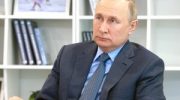The model of building a professional army of volunteers has proven its effectiveness in modern warfare.

When Russian tanks entered Ukraine, none of analysts did not think that in a few days the Russian military will cry on camera , beg their parents for help and surrender voluntarily to Ukrainian troops.
One common explanation for this sudden turn of events is the fact that the Russian military is using conscripts with limited skills and low morale. The involvement of such troops may indicate the desperation of Vladimir Putin and the fact that he has few options left. However, the Armed Forces of Ukraine also includes conscripts, but do not suffer from similar problems with personnel, – writes the Wall Street Journal.
The Western media paid the most attention to how conscription could affect the results on the battlefield. Russia's failure to win quickly supports the findings of some studies, which show that armies of conscripts fight worse than professional armies filled with volunteers. The heavy losses also confirm that governments tend to treat conscripts lightly because they are easy to replace. That is why such soldiers suffer from low morale for the simple reason that none of them wants to be on the battlefield. This problem is exacerbated when the military reflects social inequality and less prosperous recruits have to serve with more privileged volunteers. Conscription also creates disciplinary problems. Soldiers are deserting, betraying the service en masse or even staging riots.
Read also: The Russian Army fails to “compensate” for the loss of personnel at the expense of contractors – the SBU
ZSU seems to have managed to avoid all these problems by supporting the country's defense among both the military and the population. If Russian soldiers feel that the government has thrown them into the war, Ukrainians will voluntarily join the army out of patriotic feelings. Former conscripts form a base of experienced reserve forces, which complements volunteers very well. This allowed Ukraine not to use unprepared and unmotivated civilians in defense.
Meanwhile, Russia will have to recruit new groups of conscripts who have limited training and have not served in the army for more than a year. This time will not be enough to master the skills needed to conduct complex modern military operations. If the war drags on and comes to a standstill, and Ukraine needs additional replenishment due to heavy losses, it could face the same problems that the Russian army is suffering from today.
Conscripts are not only ineffective on the battlefield, but also potentially dangerous at home. Coverage of the war in the Russian media is tightly controlled by the authorities. But Putin cannot hide the reality that soldiers do not return home. Dissatisfaction with the use of conscripts in the war against Ukraine has already begun to spread in Russia. This could be a political challenge for Putin, who will prevent more troops from being recruited. Or he may dare to openly declare war to cover up the mouths of disgruntled Russians. Both options will affect the stability of the Russian state and Putin's rule. And all this in the short term.
Large-scale use of conscripts can have a profound effect on post-war society. As many veterans return home crippled, the state will have to provide for them for the rest of their lives. Meanwhile, the deaths of soldiers will have a negative impact on the Russian economy. Retirees who do return home can also create social tensions and mobilize around their frustration with the government.
Read also: Danilov believes that the war will be long
Outside of Russia, other countries, watching the war, recalled the use of conscripts. European armies were inclined to abandon compulsory conscription in favor of building more local but more professional volunteer armies. However, in recent years, conscription has begun to return to the continent. Several countries that have previously refused to hold prizes have either returned them or started public debates on the subject. Fear of Russian aggression could force more countries to return to compulsory military service. Governments may decide that a larger army, as well as the ability to quickly deploy reserve troops, is the best deterrent. Even countries that are not directly threatened by Russia can follow this path. Because countries often build their armies based on common practices that are considered most appropriate.
But if countries such as Germany feel the need to resume conscription, it may limit their ability to work with partners as a combined force. For years, NATO aspirants have given up conscription and invested more resources in well-trained and well-off armies, preferred by the most powerful members of the alliance.
China has the largest army in the world, filled with conscripts. Most likely, the country is now learning from Russia's failures in the war against Ukraine. Due to the successful resistance of the Armed Forces against the Russian army of conscripts, there were calls for Taiwan to build an army of volunteers on the model of Ukraine. The move would signal determination and make China aware that any attempt to attack the island would lead to a long war of attrition, for which the Chinese army of conscripts is not ready at all. Other countries must also pay attention to the challenges that Russia has faced in Ukraine. Should we abandon the model of the volunteer army, which has already shown how effective it is in modern wars.
See the special topic: Iskanders ”and up to 6 planes – General Staff Invaders can use this technique for air and missile strikes in Ukraine. Russia's war has taken away more than half of Ukraine's GDP – IED Ukraine's post-war reconstruction will require tremendous efforts. Russia has missed $ 6.5 billion in oil and gas revenues in two months The Russian Finance Ministry calls this simply a “deviation.” War in Ukraine: map of hostilities as of May 6 The occupiers have not been able to move forward compared to the previous day. The Armed Forces regained control over five settlements in the Slobozhansky direction – the General Staff Ukrainian defenders also drove the occupiers out of the village of Cherkasy Tyshky.




